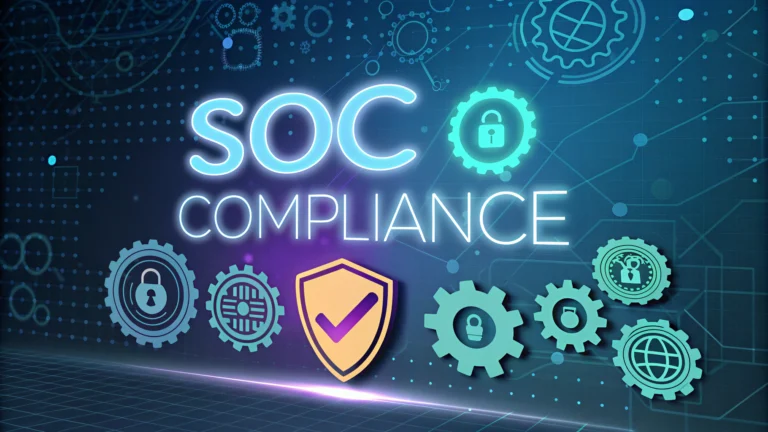SOC 2 penetration testing evaluates security controls and identifies vulnerabilities in organizations seeking SOC 2 compliance.
Regular penetration testing helps organizations maintain strong security posture and meet SOC 2 Trust Services Criteria requirements.
This guide explains key aspects of SOC 2 penetration testing, test types, and practical implementation steps.
Key Components of SOC 2 Penetration Testing
- External Network Testing
- Internal Network Testing
- Web Application Testing
- API Security Testing
- Social Engineering Assessment
- Physical Security Testing
Testing Frequency Requirements
SOC 2 requires annual penetration testing at minimum, with additional tests after significant system changes.
| Risk Level | Recommended Testing Frequency |
|---|---|
| High | Quarterly |
| Medium | Semi-annually |
| Low | Annually |
Penetration Testing Methodology
- Planning and Reconnaissance
- Define scope and objectives
- Identify testing boundaries
- Gather system information
- Vulnerability Assessment
- Scan for security weaknesses
- Identify potential entry points
- Document findings
- Exploitation
- Attempt controlled breaches
- Test security controls
- Document successful exploits
- Reporting
- Document findings
- Provide remediation steps
- Prioritize fixes
Common Testing Tools
- Nmap – Network mapping and port scanning
- Metasploit – Exploitation framework
- Burp Suite – Web application testing
- Wireshark – Network traffic analysis
- OWASP ZAP – Web app vulnerability scanning
Documentation Requirements
SOC 2 penetration testing reports must include specific elements to satisfy audit requirements.
- Executive Summary
- Testing Methodology
- Findings and Risk Ratings
- Remediation Recommendations
- Technical Details
- Test Evidence
Best Practices for Implementation
- Use certified penetration testers (OSCP, CEH, GPEN)
- Maintain detailed testing logs
- Follow established testing frameworks (NIST, OSSTMM, PTES)
- Create incident response procedures
- Establish clear communication channels
Taking Action on Results
Each identified vulnerability requires a documented remediation plan with clear timelines.
| Risk Level | Remediation Timeline |
|---|---|
| Critical | 24-48 hours |
| High | 1 week |
| Medium | 30 days |
| Low | 90 days |
Moving Forward with Security
Successful SOC 2 penetration testing requires ongoing commitment to security improvements and regular testing cycles.
Contact certified penetration testing providers or security consultants to begin your SOC 2 compliance journey.
For more information about SOC 2 penetration testing requirements, contact the AICPA at +1 888-777-7077 or visit www.aicpa.org.
Testing Documentation Management
Proper documentation management ensures compliance with SOC 2 requirements and facilitates future audits.
- Maintain version control for all test reports
- Store documentation in secure, accessible locations
- Track remediation progress and evidence
- Document review and approval processes
Continuous Monitoring Requirements
SOC 2 penetration testing should integrate with continuous monitoring practices.
- Automated vulnerability scanning
- Security event logging
- Asset inventory tracking
- Configuration management
- Access control monitoring
Integration with Risk Management
Risk Assessment Integration
- Align testing scope with risk assessments
- Update risk registers based on findings
- Adjust security controls as needed
Compliance Mapping
- Map findings to SOC 2 controls
- Track compliance requirements
- Document control effectiveness
Strengthening Your Security Posture
Regular penetration testing forms the foundation of a robust security program and SOC 2 compliance strategy.
- Implement continuous improvement processes
- Maintain testing documentation
- Update security policies based on findings
- Train staff on security awareness
- Review and adjust security controls regularly
Organizations should view SOC 2 penetration testing as an ongoing process rather than a one-time requirement. Success depends on commitment to security excellence and regular evaluation of controls.
FAQs
- What is SOC 2 penetration testing and why is it important?
SOC 2 penetration testing is a security assessment that simulates real-world attacks to identify vulnerabilities in systems, applications, and infrastructure within the scope of SOC 2 compliance. It’s essential for validating security controls and demonstrating commitment to data protection. - How often should SOC 2 penetration testing be performed?
SOC 2 penetration testing should be conducted at least annually and after significant infrastructure or application changes to maintain compliance and ensure continuous security posture. - What areas does SOC 2 penetration testing typically cover?
Testing covers external and internal network infrastructure, web applications, APIs, cloud environments, authentication mechanisms, and access controls relevant to the SOC 2 Trust Services Criteria. - Who should perform SOC 2 penetration testing?
Testing should be conducted by qualified, independent security professionals or firms with experience in SOC 2 compliance requirements and penetration testing methodologies. - What’s the difference between vulnerability scanning and penetration testing for SOC 2?
Vulnerability scanning is automated testing to identify known vulnerabilities, while penetration testing involves manual testing and exploitation attempts to validate security controls and identify complex vulnerabilities. - What documentation is required for SOC 2 penetration testing?
Documentation must include detailed test results, methodologies used, vulnerabilities identified, risk ratings, remediation recommendations, and evidence of testing completion and remediation efforts. - How does penetration testing relate to SOC 2 Trust Services Criteria?
Penetration testing primarily addresses the Security and Availability criteria by validating controls for system protection, unauthorized access prevention, and system resilience. - What should be done after SOC 2 penetration testing identifies vulnerabilities?
Organizations must develop and implement a remediation plan, prioritizing fixes based on risk levels, and maintain documentation of remediation efforts for SOC 2 audit evidence. - How does cloud infrastructure affect SOC 2 penetration testing requirements?
Cloud environments require specific testing approaches and coordination with cloud service providers, ensuring testing complies with provider policies while adequately assessing security controls. - What are the common SOC 2 penetration testing methodologies?
Testing typically follows established frameworks like OWASP, NIST, and PTES, incorporating black box, white box, or gray box testing approaches based on specific requirements.







